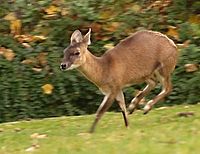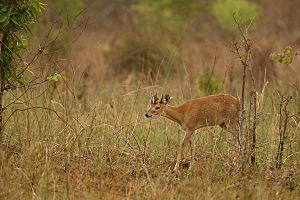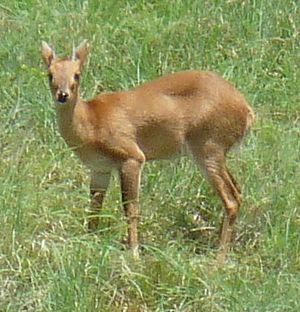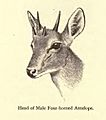Four-horned antelope facts for kids
Quick facts for kids Four-horned antelope |
|
|---|---|
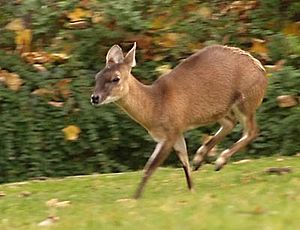 |
|
| Conservation status | |
| Scientific classification | |
| Kingdom: | |
| Class: | |
| Order: | |
| Family: | |
| Subfamily: | |
| Genus: |
Tetracerus
|
| Binomial name | |
| Tetracerus quadricornis |
|
The four-horned antelope (Tetracerus quadricornis) is a special type of bovine animal. It is also known by its Hindi name, chousingha. This animal is unique because it has four horns, unlike most bovines that only have two.
Four-horned antelopes are fairly small. They stand about 60 centimeters (2 feet) tall. They weigh around 20 kilograms (44 pounds). Their fur is light yellowish-brown with a white belly. They have a black stripe on their front legs. Only the males have four horns. The back horns can be about 10 centimeters long, while the front horns are shorter, up to 4 centimeters long.
These antelopes live in India and Nepal. They prefer to live in forests. Four-horned antelopes usually live alone. They mainly eat grass.
Sadly, four-horned antelopes are hunted. People hunt them for their unique four horns as trophys. They are also hunted for their meat. Because of hunting and losing their homes (habitat loss), there are now fewer than 10,000 four-horned antelopes left.
Contents
About the Four-Horned Antelope
The four-horned antelope is one of the smallest bovids in Asia. Its four horns make it stand out from most other bovids, which usually have only two horns. An adult four-horned antelope is about 55 to 64 centimeters (22 to 25 inches) tall at the shoulder. It weighs between 17 and 22 kilograms (37 to 49 pounds). Its body length is usually 80 to 110 centimeters (31 to 43 inches).
Males and females look quite similar, but only the males have horns. These antelopes have thin legs and a short tail. Their coat can be yellowish-brown to reddish. Their belly and the inside of their legs are white. They have black marks on their muzzle (nose area) and behind their ears. A black stripe runs down the outside of each leg. The hair feels rough, more like a deer's fur than the smooth fur of other antelopes.
One pair of horns is found between the ears, and the other pair is on the forehead. The back horns are always longer than the front horns. The front horns might even look like small bumps covered in fur. The back horns measure about 8 to 12 centimeters (3 to 5 inches). The front horns are smaller, measuring 2 to 5 centimeters (1 to 2 inches). These horns start to grow when the antelope is 10 to 14 months old.
The four-horned antelope is very different from the nilgai. The nilgai is much larger and has only two horns. The four-horned antelope can sometimes be confused with deer like the Indian muntjac or the hog deer. However, antelopes do not have antlers like deer do. The chinkara, a type of gazelle, can be recognized by its lighter brown coat and larger, ringed horns.
Life and Habits of the Four-Horned Antelope
The four-horned antelope is mostly active during the day (this is called diurnal). However, it often rests or chews its food (this is called ruminating) in thick bushes during the hottest part of the day. These antelopes usually live alone. Sometimes, they might form small groups of three to five animals. These groups can include one or more adults, sometimes with young ones. Males and females usually only meet during the mating season.
This antelope is shy and tries to stay hidden. If it senses danger, it will stand still. Then, it might nervously jump away or run very fast. It often hides in tall grasses to avoid animals that hunt it. It does not usually make alarm calls to warn others. This is because it tries to avoid drawing attention to itself. But in very dangerous situations, it might call out to let predators know it has seen them.
Adult males mark their areas (their territories) by rubbing a special gland near their eyes on plants. This leaves a clear liquid that soon turns into a white film. They also use specific spots as bathrooms, creating piles of their droppings. These spots can be confused with those of barking deer, but the antelope's droppings are longer and larger. When an antelope wants to show it is not a threat, it will lower its head, pull its ears back, and make its body look smaller. Large predators like tigers, leopards, and dholes (wild dogs) hunt four-horned antelopes.
What They Eat
The four-horned antelope eats many different plants. Its diet includes grasses, herbs, shrubs, leaves, flowers, and fruits. Studies show they prefer certain types of grass. They also eat leaves from trees like Cordia wallichii and Emblica officinalis. Grass makes up about 29 percent of their diet. Leaves from trees make up about nine percent. They eat about equal amounts of grass and leaves.
They are careful when they eat. They often lift their heads to look around for danger. Four-horned antelopes need to drink water often. Because of this, they usually stay in places close to water sources.
Reproduction and Life Cycle
Not much is known about how four-horned antelopes reproduce in the wild. It is thought that females can have their first baby before they are two years old. The breeding season likely happens from May to July in some areas, and from June to August in others.
When a male approaches a female, he walks calmly and makes soft coughing sounds. They might even kneel and gently push each other with their necks. The mother carries her baby for about eight months. After this, one or two calves are born. A newborn calf is about 42 to 46 centimeters (17 to 18 inches) long. It weighs about 0.7 to 1.1 kilograms (1.5 to 2.4 pounds). Young calves are kept hidden for the first few weeks after birth. Calves usually stay with their mothers for about a year.
Where They Live
The four-horned antelope lives in areas with lots of grass or thick bushes. They also need to be close to water. They usually stay away from places where humans live. Even though they can live in different types of environments, they mostly prefer open, dry forests with deciduous trees (trees that lose their leaves) in hilly areas.
These antelopes used to be common in the forests of India. Now, their numbers are low. In 2001, there were estimated to be just over 10,000 of them. Their numbers are believed to be still going down. Most of the four-horned antelope populations are in India. Smaller numbers are found in nearby Nepal.
Dangers and Protection
The four-horned antelope is in danger because its natural home is being lost. This happens when land is cleared for farming. Also, their unique four-horned skulls and horns are popular with trophy hunters.
In India, this species is protected by the Wildlife Protection Act of 1972. This means it is illegal to hunt them. The population in Nepal is also listed in CITES Appendix III, which helps control trade of these animals. The International Union for Conservation of Nature (IUCN) lists the four-horned antelope as a Vulnerable animal. This means it faces a high risk of becoming extinct in the wild.
Many protected areas in India are home to four-horned antelopes. These include:
- Gir National Park (Gujarat)
- Bandhavgarh National Park (Madhya Pradesh)
- Kanha National Park (Madhya Pradesh)
- Panna Tiger Reserve (Madhya Pradesh)
- Ranthambore National Park (Rajasthan)
- Sariska Tiger Reserve (Rajasthan)
Images for kids
See also
 In Spanish: Antílope de cuatro cuernos para niños
In Spanish: Antílope de cuatro cuernos para niños




